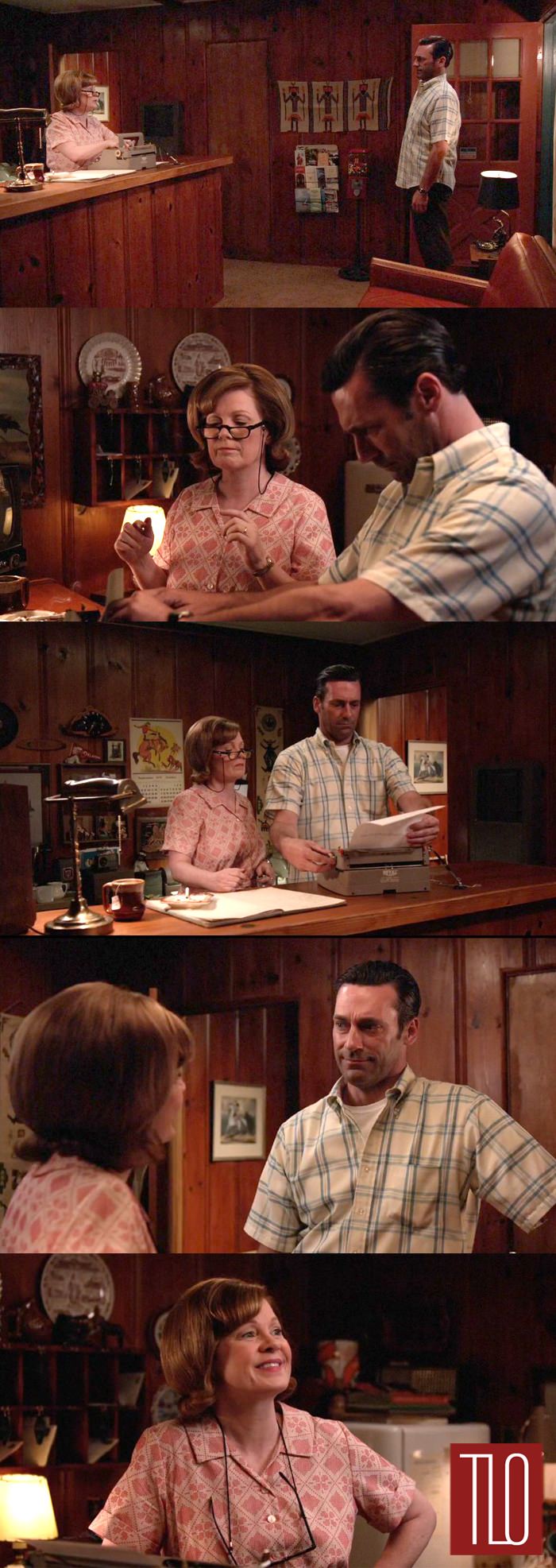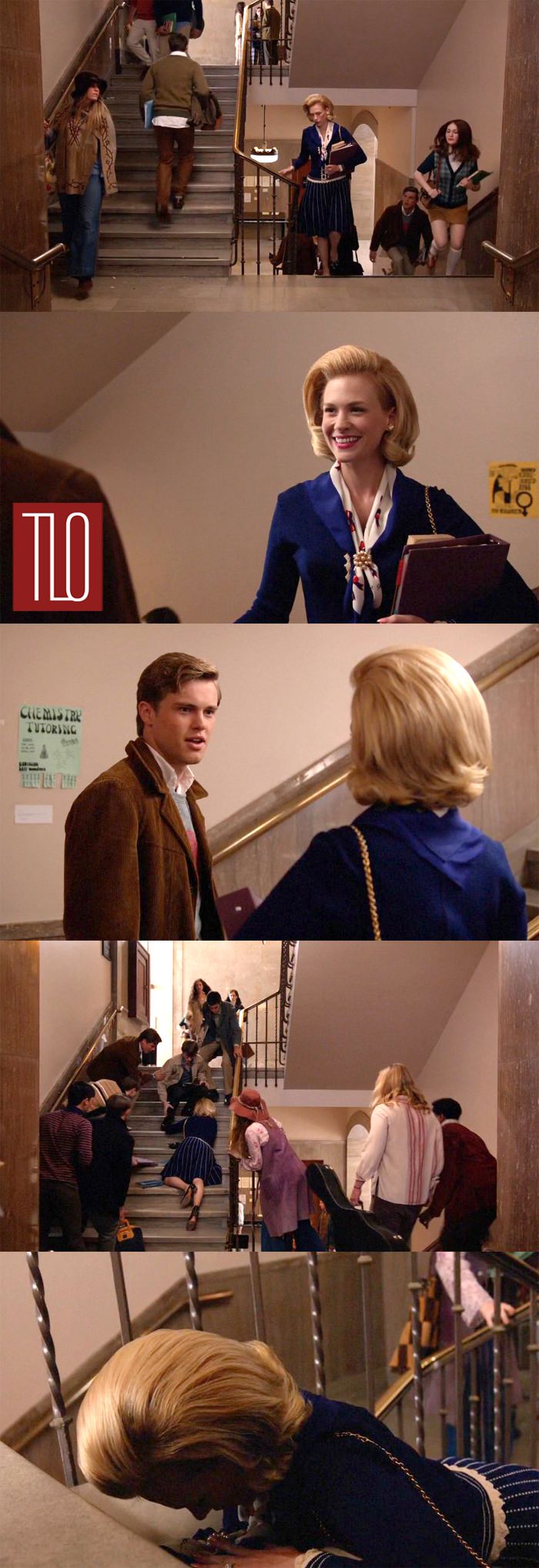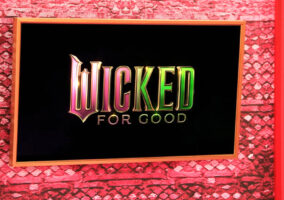In some ways, this was the hardest Mad Style entry we’ve ever written. Not just because the subject matter was so sad and depressing, but because it took us quite some time to come to terms with the themes in the costuming this week, because they were, for once, very straightforward and basic in a lot of ways. This is fitting in its own way because learning to accept one’s mistakes (as in Pete’s case), learning to let go of the past (as in Don’s) and learning to accept the inevitability of one’s death (as in, obviously, Betty’s case) are simple, human, universal tales. It’s been true for some time now that Mad Men has gotten less and less subtle with each passing season. Well, here we are at the penultimate episode, telling stories as old as fire and as simple as The Golden Rule.
Given the themes and natures of these stories, it shouldn’t be surprising that the costuming motifs to look for this week are so universal as to be archetypal: Madonnas, brides, angels (of death), and the sacred feminine. Also, in true Mad Men fashion, the inexorable pull of family ties, long after a family has broken up and even a little bit of ironic patriotism.
Grab some tissues and let’s get to it.

We figured we’d slam you with the hardest shots to look at first, just to get them out of the way. These were some of the most beautifully composed shots in the entire run of the series and this is the very best acting January Jones has ever done, by far. Just heart-wrenching.
From a costuming motifs perspective, it’s also one of the most important scenes in the episode. Pink and blue are not only two of Betty’s signature colors, going back a decade and with countless examples in the years since, but they are also, in modern western culture, the colors that signify maternity. Maybe slightly less so now, but very much so in 1970. They’re baby shower colors, which makes their usage here all the more darkly tragic. This is not a hopeful soon-to-be-mother celebrating impending life. She’s a devastated mother realizing hers is coming to an end.
It’s important to note that this is the last time we see Betty acting passively. She’s sitting quietly and letting the men talk. Pink is a color that signifies traditional femininity and in Betty’s case, she has always defined femininity as “wife.” It was her goal in life growing up, it had been the number one goal she’d been planning for her daughter, and it was the role in which she took the most pride in her life. Countless scenes over the years indicated that she simply could not imagine a life as an adult woman that didn’t include a husband in the picture. She always had problems in her role as a mother, but you can’t fault Betty Hofstadt for not being a devoted wife. Still, her passivity is a mask in this scene. She’s quiet not because she’s deferring to the men, but because she’s coming to an acceptance of her fate and making plans for how she wants to handle it. She will not wear pink again after this scene, nor will we ever see her this passive again. Instead, she wears blue and white, over and over again throughout the episode.
But the pink-as-wife motif was picked up by the other female characters:




And always as a counterpoint to a man in blue. The motel owner’s wife is conservative, conciliatory, and speaks either to or of her husband in both scenes. And of course, both of Trudy’s scenes in pink were, in effect, marriage proposals.
As an aside, the motel wife’s hair is quickly passing out of style at this point in time, while Trudy’s hair is pure seventies.
Back to Betty:

What’s notable about this scene (aside from the blue-and-white motif it establishes for the rest of the episode) is how maturely Betty’s dressed, in a setting surrounded by people almost young enough to be her own children. She clearly enjoys the attention of a cute co-ed boy, but she isn’t kidding herself about how they see her. As her final note to Sally indicated, she’s still a woman who loves being seen as pretty and whose looks are important to her, but she’s not vain in the sense that she wants to be mistaken for younger than she is. If anything, Betty was proud of her increasing maturity as the years went on. She liked being seen as a wife to a powerful and connected man. Once she married Henry, she immediately switched from the pretty little former-model wifey-poo outfits of Don Draper’s wife to much more mature and sober suits and helmet hair, more appropriate both for her role as a political wife and the fact that her second husband was notably older than her, with grown children of his own. She’s always wanted to be seen as beautiful – and note just how extremely put-together she is here – but to her credit, she effectively shed the child-like affect she had in her first marriage and embraced maturity in her style.

This is underlined by the fact that the students who dropped her off at the hospital told them her name was Mrs. Robinson, the older woman in The Graduate who seduces a man young enough to be her son. Betty seemed to find it not only amusing, but slightly flattering. To her, the ageism crack was water off her back. It was more important that the boys saw her as attractive.
This is not the first time we’ve seen a nursing cap this season, which tells us that the earlier scene with Stan’s girlfriend was a form of costume foreshadowing. We’ve also seen a whole lot of women wearing white or predominantly white outfits all season long. We saw that in some cases as a bridal motif (and in Trudy’s case, we think we were proven right), but it can also be seen in an angelic light or even as a color that signifies death, which it does in many cultures.
Meanwhile, half a continent away…

Don is feeling the pull of old family ties, even if he doesn’t know it yet. Not only is he in blue and white, like the mother of his children, but his jacket is pretty much an exact match to the blue Betty’s wearing in the previous scene, where she gets news that is going to affect Don’s life on a profound level.
This is not the only familial tie that’s manifesting in Don’s clothing.

He and Sally are in similar shades of pale green when they speak on the phone, in a scene meant to indicate that Don hasn’t abandoned his children and has no plans to, even as he sheds all the other parts of his life. It’s notable that Sally seems to really admire her father for hitting the road like this and they talk about the trips she wants to take and the wish that she could be by his side while he takes this one. She’s got the same hobo traits he does.
We might as well keep going with this. Note the plaid in her pants. It’s a Sally motif that’s usually deployed to signify the ties she has with her father and she almost always wears it in an episode where Don also wears plaid:
Right on cue:

Put a pin in that one for a moment.
Let’s look at another shattered family, calling out to each other in their clothes.
The reds of Pete’s and Tammy’s outfits call to each other, even as they also reference the apple-picking they did together. But Tammy’s also got notable touches of yellow and white in her outfit, which ties her very much to her mother.
 Yet another example of women in white. We think it’s safe to say that in Trudy’s case, this really does underline a bridal theme and not a death or angelic one – although granted, Pete does tend to view her as an angelic figure that will save him somehow. Still, we’ll stick with bridal, which is what we settled on the last time she wore white.
Yet another example of women in white. We think it’s safe to say that in Trudy’s case, this really does underline a bridal theme and not a death or angelic one – although granted, Pete does tend to view her as an angelic figure that will save him somehow. Still, we’ll stick with bridal, which is what we settled on the last time she wore white.
As an aside:

This is clearly a callback both to this scene and to the end of the pilot episode, when Don came home to Betty and the kids.
As another aside, just before he left the kitchen scene above, Pete called Tammy his little “Wonder Woman.”
*SMASH CUT TO 2015*
 Tammy Campbell, Princess of Wichita.
Tammy Campbell, Princess of Wichita.
We’re sorry, but we had to. The minute we saw that stripper, we burst out laughing. Is it even possible that this was a coincidence? We find it hard to believe so. Sure, the whole Oklahoma interlude was meant to be a commentary on “middle America” and how its values are no more pure than those of big city folks who live in toilets like New York City, which makes the patriotic theme of her costume all the more ironic and appropriate, but we have a hard time believing it’s not also meant to call back to that Wonder Woman line.
Note that Don puts on a little bit of his old Don Draper armor – that suit jacket and white shirt – to enter a situation that felt slightly threatening. Note also that this is the suit Don was wearing when he walked out of McCann and out of his old life. More importantly, he walked out of a meeting in which a slick marketing research guy was describing a mythical middle-American male full of likeable attributes and benign good will. Nothing like the violent, ignorant, xenophobic men Don encountered in the real middle-America; the one not mythologized by Madison Avenue. There’s a reason the radio was playing “Okie from Muskogee” in Don’s dream. It’s because the lyrics were all about that tension between coastal and middle America; a tension which grew during the cultural revolution and which has informed all of American politics in the half-century since. Don looks like exactly what he is here: a city slicker slumming with the locals. And despite their faux and forced good will toward him in this scene, it became obvious that the locals saw him in exactly that way.
 You could also apply the “ironically patriotic” take to Andy, who’s dressed in red, white and blue when he tries to shake Don down for a little extra cash. Note that there is nothing remotely 1970-trendy about Andy’s outfit. Granted, he’d have no reason to be trendy in this job, but his jeans are straight-legged and his hair is 1965-short, indicating, much like the motel owner’s wife, that the small towns and out-of-the-way places tend not to be up on the latest looks.
You could also apply the “ironically patriotic” take to Andy, who’s dressed in red, white and blue when he tries to shake Don down for a little extra cash. Note that there is nothing remotely 1970-trendy about Andy’s outfit. Granted, he’d have no reason to be trendy in this job, but his jeans are straight-legged and his hair is 1965-short, indicating, much like the motel owner’s wife, that the small towns and out-of-the-way places tend not to be up on the latest looks.
Even here, Don’s in a blue-and-white that calls to the mother of his children:
 As we noted, once she shed the pink in her outfit, she shed any vestiges of wifely passivity left in her. She’s taking full control of the situation and telling Henry how it’s going to be. And as she noted in this scene, all of her energy right now is devoted to how she’s going to tell and deal with her children. Very much a madonna-and-child color scheme.
As we noted, once she shed the pink in her outfit, she shed any vestiges of wifely passivity left in her. She’s taking full control of the situation and telling Henry how it’s going to be. And as she noted in this scene, all of her energy right now is devoted to how she’s going to tell and deal with her children. Very much a madonna-and-child color scheme.

Although with slightly ironic undertones, since there’s absolutely no maternal affection shown in this scene or detected on the part of Sally. Which isn’t to say that love didn’t inform Betty’s actions and concerns here; just that she was not going to suddenly become demonstrably affectionate with Sally now. It would have been false and it would have made Sally more upset.
There’s also very much an angelic or ghostly quality to Betty, especially as she enters and exits the room, bathed in light.

And in her final scene, both the madonna imagery and the angelic imagery merge, as she finally, after all this time, tells her daughter she loves her and ascends slowly, painfully toward the light.
But there’s another, simpler reason as to why she wore blue and white all throughout this episode.
 Because she thinks it makes her look her prettiest, of course.
Because she thinks it makes her look her prettiest, of course.
Meanwhile, as Betty ascends…
 Don has cut himself free of just about everything, including the lingering Dick Whitman guilt of causing Don Draper’s death. He’s happier than he’s ever been, with no more ties to his old life. He’s also dressed in blue, orange, brown and green.
Don has cut himself free of just about everything, including the lingering Dick Whitman guilt of causing Don Draper’s death. He’s happier than he’s ever been, with no more ties to his old life. He’s also dressed in blue, orange, brown and green.
Now name all the colors of these costumes:
 It remains to be seen if he heeds the call, but make no mistake, his children are calling out to him.
It remains to be seen if he heeds the call, but make no mistake, his children are calling out to him.
Do what you have to to come home, Don.
If you’d like to hear our interview with Mad Men’s Costume Designer Janie Bryant, you can go here (4/3/15 podcast).
You can also hear Tom discussing this episode on the Ryan & Ryan podcast, with Mo Ryan and Ryan McGee, here.
For more discussion on your favorite shows, check out our TV & Film forum.
[Photo Credit: Frank Ockenfels 3/AMC- Stills: Blood, sweat, and tears of tomandlorenzo.com]
Mad Men: The Milk and Honey Route Next Post:
Mad Men: Person to Person
Please review our Community Guidelines before posting a comment. Thank you!





